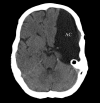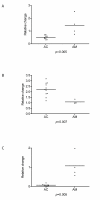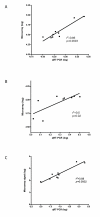Microarray-based gene expression profiling and DNA copy number variation analysis of temporal fossa arachnoid cysts
- PMID: 20187927
- PMCID: PMC2841093
- DOI: 10.1186/1743-8454-7-6
Microarray-based gene expression profiling and DNA copy number variation analysis of temporal fossa arachnoid cysts
Abstract
Background: Intracranial arachnoid cysts (AC) are membranous sacs filled with CSF-like fluid that are commonly found in the temporal fossa. The majority of ACs are congenital. Typical symptoms are headache, dizziness, and dyscognition. Little is known about genes that contribute to the formation of the cyst membranes.
Methods: In order to identify differences in gene expression between normal arachnoid membrane (AM) and cyst membrane, we have performed a high-resolution mRNA microarray analysis. In addition we have screened DNA from AC samples for chromosomal duplications or deletions using DNA microarray-based copy number variation analysis.
Results: The transcriptome consisting of 33096 gene probes showed a near-complete similarity in expression between AC and AM samples. Only nine genes differed in expression between the two tissues: ASGR1, DPEP2, SOX9, SHROOM3, A2BP1, ATP10D, TRIML1, NMU were down regulated, whereas BEND5 was up regulated in the AC samples. Three of the AC samples had unreported human DNA copy number variations, all DNA gains.
Conclusions: Extending results of previous anatomical studies, the present study has identified a small subset of differentially expressed genes and DNA alterations in arachnoid cysts compared to normal arachnoid membrane.
Figures



References
-
- Sakai N, Kumagai M, Ueda T, Iwamura M, Nishimura Y, Miwa Y, Shimizu K, Hirata T, Andoh T, Yamada H. [Clinical study on intracranial arachnoid cyst: with reference to the middle cranial fossa] No Shinkei Geka. 1989;17:117–123. - PubMed
LinkOut - more resources
Full Text Sources
Other Literature Sources
Molecular Biology Databases
Research Materials
Miscellaneous

